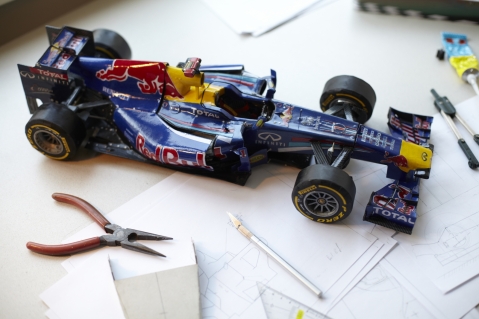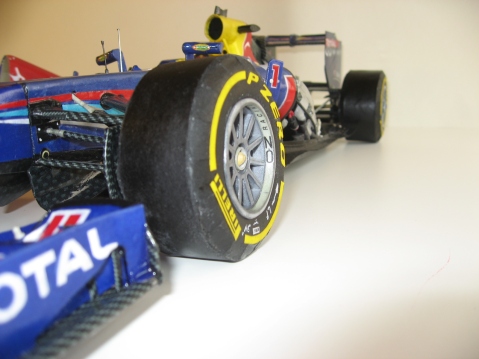Red Bull Racing Student Placement
I’m very happy finally to announce, that I’ll start working at Red Bull Racing/Red Bull Technology in summer this year. This placement will be for one year and will give me big insights into the development of a F1 car.
It’s a lifedream of me to work in a F1 Team and that it becomes real in that early stage in my life, even before I’ve finished my engineering studies, that’s really great and I’m also a bit proud of that.
The offer for this job, I got in the course of the building process of my Red Bull RB7. There I got an email from Red Bull where they invited me for an interview in Milton Keynes.
I want to say thank you to all of my friends, fans and followers who make my blog that well-known in professional circles.
And of course a very great thank you to Red Bull Racing/Red Bull Technology to give me such a big chance that early in my life!
with best regards,
Paul Bischof
comparison of modern rear wings – F1 vs. LM
For given reasons, namely finishing the Audi’s rear wing, I’ll do a little comparison between modern (2011) F1 (Red Bull RB7) and LM (Audi R18 TDI) rear wings.
In generally you can say, that F1 is much more (very much more) regulated than Le Mans cars. Only if we take a look on the tech regulations, you can see the enormous difference. On the one hand the F1 tech regs with 74 pages and on the other hand the LM tech regs with 52 pages each with English and French text. So in reality we have the F1 regs with 74 pages and the LM regs with 26 pages!
Also the notation is quite different. In the F1 regs you won’t find the word rear wing or end plate. There you can interpret the “bodywork behind the rear wheel centre line” (Article 3.10) or “width behind the rear wheel centre line” (Article 3.5) against the LM regulations where you can literally read the regs for “Rear wing” (Article 3.6.3) in point “3.6 – Aerodynamic devices”.

Rear view of the two cars (Red Bull RB7 and Audi R18 TDI). Even here you can see the enormous difference between the dimensions of these two wings. The Red Bulls wing is in Monza configuration, the Audis wing is in Le Mans configuration. So, both cars drive with very low downforce.

The wings projected area viewed from above is about 245.000mm² for the RB7 and 240.000mm² for the R18 TDI. You can see, even if the F1 wing has not half the width of the LM wing, they have both about the same surface.

Current F1 rear wing elements are quite similar to LM wing elements. A few more small details, but not really different. The cross section of the wing elements is a bit thinner and not that much like a standard wing section like it is at LM cars.

Even a LM car is 80mm higher than a F1 car, the rear wings are allowed to be at almost the same height. 950mm at F1 cars and 965mm at LM cars (although Audi does not exploit the full height).

At the end plates, you can see a really big difference. Where the LM end plates are really only there for closing the wing, the F1 end plates have great aerodynamical influence on the cars rear end. I’m no aerodynamicist and I won’t strike out trying to explain this circumstance, but I think it’s clearly visible, that the EP’s function is not only there to closing off the wing.
Photoshoot in Graz for Pictures of the Future Magazine
In May 2012, the Siemens AG contacted me for featuring me and my work in their Pictures of the Future Magazine. Shortly later there was a fotoshoot with me and my RB7. Here are a few pics of this photoshoot.
Link to the article: Pictures of the Future Jugend-Sonderausgabe 2012
All pics copyright by SIEMENS AG
For more pics go to my Facebook site: facebook.com/paulsf1/media
For more pics go to my Facebook site: facebook.com/paulsf1/media
Red Bull RB6 Tamiya kit on sale
More than half a year after the completion of my Red Bull RB7 and more than a year after abortion of my RB6, the RB6 is now on sale as a kit. Tamiya Corporation releases the kit this week on the Hobby Search fair. It’s scale is 1:20, so half size of my 1:10 cars.
I’m curious to see if the model can achieve the level of detail and the quality of my Red Bull. When I look at the pictures of the engine and gearbox, I doubt it. Especially the f duct looks shonky to me – the activation pipe to the cockpit is missing completely and the other pipes are much too thin. It’s also a pity, that Tamiya did not built an engine. The heat shieldings are irremovalbe. I do not want to bash Tamiya, but me, as a person who knows that car quite well, notices these things. But at least it looks better than my own RB6. 😉
pictures on scaleautofactory.com
RB6 in Hobby Search shop

Tamiyas 1:20 RB6 kit – © Tamiya

That’s how the engine bay looks. © Tamiya

That’s how the engine bay should look! – f1technical.net

My RB7 on the autumn fair Graz (Grazer Herbstmesse) two weeks ago.
article on PaulsF1 in “Pictures of the Future” magazine of the Siemens company
Last week, a new edition of the Pictures of the Future magazine of the Siemens company appeard. In it an article on PaulsF1. As you maybe know, Siemens is software supplier of Red Bull Racing. The article is only avilable on german.
The RB7 unveiled
Started on April 10th 2011, 308 days after cutting the first part, after about 800 hours of designing and manufacturing of about 6500 single parts within 10 month. After converting 534 grams of paper, after hours and hours of studying pictures, books, technical regulations. After several hours of drawing, creating and designing parts, now, on February the 11th, 2012, all together results in a model of a great car, which won the 2011 Formula 1™ drivers as well as constructors championship. Created by a design team, located in Milton Keynes, UK, lead by Mr. Adrian Newey, with an insane amount of the great british engineering excellence and many creative engineers.
My own RB7 is completely one-man handcrafted (except a few sponsor labels) by myself without using any CAD program or other computer help. A Formula 1 car made by compass and straight-edge construction – when you’ve seen that last time. 😉
About a third of the building time, I spent with researching and analysing pictures, publications, any information which was available. Another relatively big amount of time I spent with drawing, creating and designing complicated parts, such as monocoque, bodywork or suspension geometry. The only really point of criticism is the not fully attachable engine cover – there’s room of improvement.
Anyway, the car is finished now. I want to say thank you to all of my friends, fans and followers for your great exaltation!
Another special thank to some very helpful sources:
- Red Bull Racing Ltd. for designing that insane antetype of my model and for their assistance of Haynes for the Owner’s Workshop Manual
- Renault F1 for publishing great pictures of their RS27-2011 engine
- Haynes for their great work Owner’s Workshop Manual
- McLaren Electronic Systems for the free access to the Formula 1TM standard electronic system data
- FIA for the free access to the 2011 Formula 1TM technical regulations and appendix
- Craig Scarborough for his analysis of 2011 F1 technology on scarbsf1.wordpress.com
- the guys on f1technical.net who published and analysed many technical photos of the RB7
- wri2.net & sutton-images.com for taking interesting technical shoots of the RB7
starting RB7s rims
Today it goes on with the rims. It’s an eerie stressful and extensive work to produce such a modern rim out of paperboard. The rear ones are semi finished (valve and lacquer are missing), at the front, the star of spokes’s missing (only the star at the rear rims consits out of 48 parts). But the work pays off if you look at the achievement at the rear axle. The regulated width of 180cm is reached at the rear, at the front it maybe could exceed because of the 4° camber angle (we’ll see that after completion). I’ve considered that in my calculations, but the manufacturing of the components out of paperboard never can be so accurate like the construction – I’ve to calculate with a tolerance of about +/-0,3mm.
repairing and pre finishing the engine cover
After the presentation of the new RB8, tomorrow we’ll get a first indication if he’s as quick like the 7, my own RB7 goes on straight to the finish line.
Beside manufacturing a new rear part for my engine cover, I’ve add a few labels, screws and so on. Now missing are only three sponsor/partner labels (RENAULT, SIEMENS, Platform Computing) and the wheels with their nuts.
manufacturing brake calipers and heat shields
At sunday I began with manufacturing of the engine cover. It’s very complex shapes were not the big problem, more the fitting to the car. After many hours of thinking and trying, a colleague suggests me, to try this one. Take very small nails, integrate them into the cover an fit as complement part tiny sleeves at the monocoque. The fricton between the nails and the sleeves should hold the cover in position. It sounds very good, and will be a very good likness of the bayonet cap of the big brother of my RB7. But I think I’ll try this one at my next model. Anyway, the cover conforms very well to the monocoque.
Today I’ve worked on the brake calipers. The brake lines and a few small parts are missing yet. Also a few parts of the air ventilation and bleed are missing. The heat shields at the engine are finished. For sure they are removable.








































